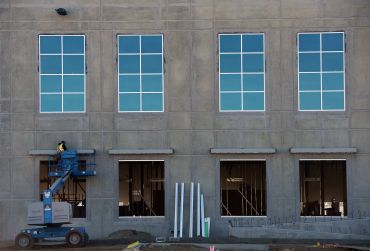Distressed Assets Keep Trickling to Market Amid Tough Economy — What Now?
By Michael Gonda July 8, 2010 4:57 pm
reprints
Of late, rarely a day goes by without news of another notable asset or portfolio of commercial investment properties being turned over to a special servicer. Properties have been becoming “distressed” at a growing rate. Distressed assets are those where value has fallen below the amount of debt or which do not have enough net operating income to service debt payments. With values, on average, down 32 percent in New York City, it is not surprising that many assets acquired in 2005, 2006 and 2007 are increasingly falling into the distressed-asset category.
We are headed into a fascinating period of time in the investment sales area. Underlying fundamentals appear to be correcting, and rent concessions in both the commercial and residential markets have been reduced significantly or eliminated.
Distressed assets have been flowing into the market with more regularity. These assets can be in the form of short sales (where the owner delivers a deed and all proceeds go to pay off the lender at a level lower than the amount of the mortgage); note sales (where the lender sells a property’s debt obligation to an investor who will proceed with the foreclosure process); or REO sales (here the lender has completed the foreclosure process and can deliver the deed to the buyer).
Each of these forms of distressed-asset sales brings about a deleveraging of the commercial real estate market. These sales have been increasing in frequency; unfortunately, there remains a long way to go before we have fully dealt with the massive deleveraging process that is required in order for the market to fundamentally recover.
Many lenders have attempted to weather the storm using techniques of “extend and pretend,” “delay and pray” and “a rolling loan gathers no loss.” These strategies are generally only effective in a circumstance where fundamentals will correct at an extent to which value will appreciate significantly. The fundamentals are getting better, but not nearly rapidly enough to save the overwhelming majority of properties underwater.
The economy appeared to be on the right track earlier this year, but, unfortunately, recent economic data has caused significant concern and could be the reason why lenders are now taking action to address their distressed assets rather than waiting and hoping that significant losses would not have to be faced.
LAST FRIDAY’S JOBS report, released by the Department of Labor, may have seemed positive to the casual observer as the official unemployment rate dropped from 9.7 percent in May to 9.5 percent in June. The administration pointed to growth in private-sector employment and declared that “we are headed in the right direction.”
At one point, so was the Titanic.
The truth behind the jobs report was that 125,000 jobs were lost in June. It is, therefore, counterintuitive for the unemployment rate to drop. However, the reduction in the rate was a largely illusory decline as hundreds of thousands of discouraged workers dropped out of the workforce-652,000 Americans stopped looking for work and, therefore, are technically no longer counted among the unemployed. The so-called participation rate is dropping as discouraged workers give up their job searches. If these folks are taken into consideration, as well as part-time employees who would prefer to be working full-time, the true unemployment rate rises to 16.5 percent.
In June, private-sector job creation hit 83,000, far below the 100,000 to 150,000 jobs needed per month just to keep up with population growth.
This poor employment report comes on top of several other economic indicators that are painting a bleak picture for the country. A recently released new home sales report was so negative it surpassed even the most pessimistic expectations. New home sales declined by a record amount in May to a new low as builders sold new homes at an annual rate of just 300,000 units. This was 32.7 percent below the 446,000 rate in April.
This shocking drop created a level even lower than that experienced during the recession in the early ’80s, when interest rates approached 20 percent. They are now at the lowest level since the government began tracking this data in 1963.
Additionally, consumer sentiment and consumer spending continued to drop. The stock market has been dropping and most economists are adjusting their forecasts for future G.D.P. growth downward. These economic indicators are exerting further downward pressure on the commercial real estate investment sales market.
The acute supply-demand imbalance and the low-interest-rate environment have been the major positive influences on the sales market. Global economic concerns have created a flight to safety and quality and, as capital worldwide has flowed into U.S. treasuries, we have seen interest rates hit remarkable lows. Last week, the 10-year T-bill was yielding less than 3 percent, and the five-year fell below 2 percent. This dynamic is helping to keep commercial mortgage rates at historically low levels.
NOTWITHSTANDING THIS LOW-interest-rate environment, distressed assets are continuing to work through the system and are doing so in greater numbers each month. The flow has not resembled the tsunami that was expected by many of us two years ago. They are coming to the market in a succession of slow, rolling waves and, consequently, activity in the sector has picked up substantially.
Massey Knakal’s Special Assets Group has completed more than 1,700 valuations during this cycle for lenders and special servicers interested in knowing the value of the underlying collateral for their loans. In 2009, our activity in this sector produced just 12 transactions. Thus far in 2010, our distressed-asset activity has shown 56 closed transactions. My colleagues in the investment sales arena report similar experiences.
The activity in the distressed-sales sector is clearly continuing to increase, quarter over quarter, as lenders and servicers increase the purging of these assets. These offerings have been met with significant demand from the investing community, producing very attractive recoveries for the sellers. While the number of distressed assets coming to market continues to pick up, the overwhelming majority of these assets have yet to work through the system.
We are headed into a fascinating period of time in the investment sales area. Underlying fundamentals appear to be correcting, and rent concessions in both the commercial and residential markets have been reduced significantly or eliminated. The abatement of these concessions reflects a 10 to 20 percent increase in rent levels. We believe that these enhanced fundamentals are exerting upward pressure on property valuations and that this is helping to move the market forward in a positive way.
However, we believe we are still in the early innings in the distressed-property sector and that we could have distressed assets coming to market, in one form or another, for several years to come. Advantageous mortgage terms have been responsible for keeping some properties afloat even if they have significant negative equity positions. These include interest-only periods, interest reserves built into financing structures and floating-rate mortgages that are indexed to rates that are at historically low levels. As these advantageous terms burn off, it is likely that these assets will be forced to the market to bring about the deleveraging that the market so desperately needs.
Based upon these observations, the investment sales business may be headed into uncharted territory. It will be interesting to see exactly how things play out.
rknakal@masseyknakal.com
Robert Knakal is the chairman and founding partner of Massey Knakal Realty services and in his career has brokered the sale of more than 1,075 properties, having a market value in excess of $6.4 billion.


